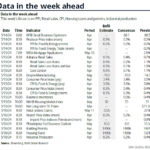
Ok, so it was just two days ago when I tweeted this:
here’s your DM rates mini-tantrum in action in stock-bond return correlations… pic.twitter.com/UPDf7DWPLD
— Walter White (@heisenbergrpt) July 18, 2017
The point was that the mini-tantrum in DM rates that Mario Draghi kicked off in Sintra, Portugal on June 27 was accompanied by sharply less negative stock/bond return correlations.
In other words, the extent to which equities were doing their part to hedge the bond selloff was diminishing. Quite a few folks suspect that’s what helped throw CTAs and risk parity for a loop, with the former turning in their worst two-week performance as a group in a decade earlier this month.
“During the week of June 26, when the bond sell-off started to weigh on risky assets, the broad SG/Newedge index, with the top 20 CTAs globally, saw the largest weekly drawdown since the GFC (Exhibit 15),” Goldman writes, in a note out Wednesday afternoon.
“Risk parity strategies have also suffered – albeit less compared with their history (Exhibit 16) – although they remain at risk from rates volatility spilling over to risky assets, as they have larger allocation to bonds compared with traditional balanced portfolios and the current low regime has likely driven higher allocations to risky assets.”

The message there was simple: a rise in rates vol. puts everything in jeopardy and the first place you’re going to see the pain is in systematic strats, which is ironic because that very same pain will likely cause those very same strats to deleverage into a falling market, thus catalyzing an even deeper selloff. (And God help us all if inverse and levered VIX ETPs are forced to panic buy VIX futs in the middle of the whole thing)
This is the subject of the above-mentioned new note from Goldman, appropriately entitled “Goldilocks and the Three Central Banks.”
Note the chart in the tweet embedded above. So that’s stock/bond return correlations. Obviously, you want that to be negative if one or the other is selling off. That’s the whole idea behind holding both stocks and bonds for diversification. Put differently, you want the equity/bond yield correlation to be positive (bond yields rise i.e. bonds selloff, stocks rise).














